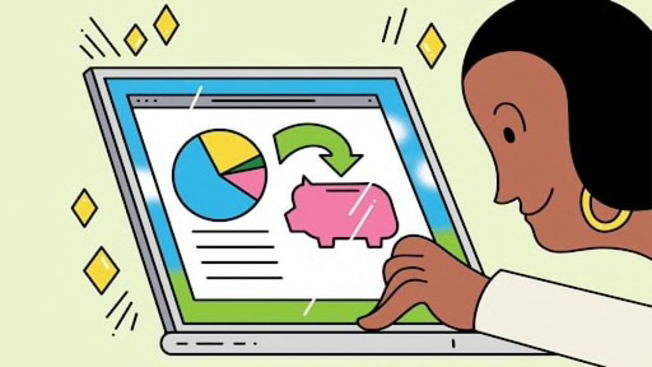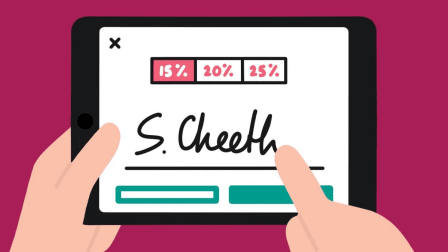Benefits and Risks of Using Personal Financial Apps and Websites
Concerned that it's too risky to use your bank's app or a service like Venmo? Here's what you need to know about the pros and cons of using digital financial tools.

When it comes to technology, I’m not what you’d call an early adopter. I still read books in print. I resist texting in favor of phone calls. And I have conducted little of my financial life online, which is ironic because I’ve been a personal finance journalist for a long time.
But moments before writing this article, I deposited my first check—a $15 insurance reimbursement—using a banking app. It was absurdly simple to do, and I instantly felt silly for clinging so long to my practice of trudging over to my bank branch to make deposits.

Illustration: Sam Island Illustration: Sam Island
Banking Apps and Websites
What they’re good for: Most of the routine tasks you might do at a bank branch can be accomplished quickly and easily on your phone, tablet, or computer. In addition to depositing checks from almost anywhere (simply by taking a photo of both sides of an endorsed check and tapping “submit”), this includes checking balances, paying bills, and transferring funds.
Online bill paying in particular can be a huge time-saver (no opening paper bills, no check writing, no buying stamps). If you’re confident that you’ll always have enough money on hand, you can set up your account to automatically pay bills that stay the same each month, such as your mortgage. And if you already authorize certain vendors, like your cable provider, to “pull” money from your bank account electronically, know that “push” payments that you authorize through your bank give you more control over your funds.
What they cost: Typically nothing beyond the standard costs of maintaining your bank accounts.
Risks to consider: The biggest is that your device is lost or stolen and someone uses it to access your money.
Precautions to take: First, protect your phone using the security settings. The names of the settings vary slightly depending on the type of phone you have. But make sure the phone is set to lock automatically after no more than a few minutes of inactivity. It can then be unlocked with a passcode or biometric authentication, which recognizes your face or fingerprint. Also, know how to remotely disable access or wipe your device clean if it is stolen or lost.
Second, in your banking app or website, enable two-factor (aka multifactor) authentication, which usually allows online account access only after you enter a password and a secret code that your bank will typically send to your mobile device in real time. Finally—and this goes for all financial technology—always use unique and complex passwords, or one of the password managers that CR recommends, such as 1Password Families and Dashlane Premium.
Peer-to-Peer Payment Apps
Apple Cash, Cash App, PayPal, Venmo, Zelle, and Others
What they’re good for: If you’re like me, once you start transferring money to friends, family members, and others using a peer-to-peer (P2P) payment app—say, to split a restaurant tab—it’ll be hard to believe you ever got along without it.
Plus, though P2P apps are intended for transfers between people who know one another, most small businesses now accept P2P payments, and some informal ones—like farmers market vendors—insist on them.
What they cost: Nothing, with a few important exceptions. You’ll be charged a 3 percent fee if you fund outgoing transactions with a credit card rather than through a bank account. And most P2P apps charge a 0.5 to 1.75 percent fee if you want to instantly transfer incoming funds to your bank account; otherwise, it takes one to three business days. (Zelle is the exception in both cases: It doesn’t allow credit card transactions, and instant access to funds is standard.)
Risks to consider: The most notorious problem is when users type in the wrong recipient address and send money to the wrong person. In such cases, the apps generally won’t reimburse users. Nor will they help (with only a few exceptions) if you’re tricked into sending money to a fraudster—if, say, you bought something online from what turns out to be a business that doesn’t really exist. In short, many of the legal rights you have when using a credit card don’t exist with P2P payments.
Also worth noting: Funds left in your P2P account might not be insured by the Federal Deposit Insurance Corp., as they would be in a bank account.
Precautions to take: Before sending money, confirm the recipient’s identity with a phone number, email address, or QR code. Consider sending a $1 test payment and confirming it was received before sending more. Move money from your P2P account into an FDIC-insured bank account as soon as possible. And turn on all identity verification options in the app.
Also, don’t broadcast to the world everyone you send money to, which is the default setting on some P2P apps. For how to prevent that, see “How to Protect Your Privacy.”
Digital Wallets
Apple Pay, Google Pay, Samsung Pay, and Others
What they’re good for: Digital wallets store credit and debit card information in your smartphone so that you can pay for things by waving your device at the credit card reader. They also have security benefits: Unlike a credit card, your phone and account data are protected by passwords, biometric authentication, and encryption if they fall into the wrong hands.
Digital wallets can also store digital event tickets and airline boarding passes, so you don’t have to dig through email at the gate or print those out in advance. They can also be used to store loyalty rewards cards, coupons, and gift cards.
What they cost: Generally nothing, but standard P2P fees may apply if you choose to use a digital wallet that way.
Risks to consider: Someone steals your phone and uses it to access your funds or card information. Or your phone dies, and you don’t have plastic cards with you.
Precautions to take: Again, make sure all available security tools are on, and that you can remotely disable or erase your phone if it’s lost. Also, keep a separate list of the cards in your digital wallet so that you can cancel them if needed. (It’s smart to do the same with the cards in your purse or wallet, too.)
Budget Apps
Empower, EveryDollar, Goodbudget, Monarch, NerdWallet, PocketGuard, Simplifi, You Need a Budget, and Others
What they’re good for: Helping you build and manage a budget by making it easy to track, visualize, and analyze your spending by category and to set savings and debt reduction goals.
What they cost: A few cost nothing, but many offer free entry-level versions and charge between $8 and $18 a month for more robust features. Many also offer a free trial period.
Risks to consider: If your phone is lost or stolen, your financial information could potentially be exposed. In addition, says CR technology and privacy policy analyst Matt Schwartz, “consumers who use these apps won’t always be able to limit the sharing and monetization of their data, especially if they live in a state with no comprehensive privacy law.”
Precautions to take: Use complex passwords, enable biometric and two-factor authentication, and know how to disable your phone from afar if it goes missing.
How to Protect Your Privacy When Using Personal Finance Apps and Websites
Another concern about financial technology is that it could leak your personal information—not only to marketers but also potentially to businesses, data brokers, and even governments that could use it inappropriately. What to do about it? Start by limiting the information your phone shares with the app. On an iPhone, go to Settings, scroll to the app in question, then deny it access to any features it doesn’t need to function, such as location tracking; on Android phones, go to Settings, then Privacy, then Permission Manager, then permission type.
Check the privacy settings within the apps as well. With Venmo, for example, the “private” setting will prevent all the world from knowing with whom you exchange money.
But those controls generally do not prevent apps from sharing your info with third parties that aren’t involved in the core service. Some providers let you opt out when you first set up an account. (Read the terms and conditions carefully.) After that, you may need to send an email or letter to the company. But a growing number of states, with support from CR and other privacy advocates, are considering laws that would prohibit companies of all kinds from collecting more data than they need without consent, and would enable consumers to easily opt out of data sharing.
Editor’s Note: This article also appeared in the February 2024 issue of Consumer Reports magazine.




















